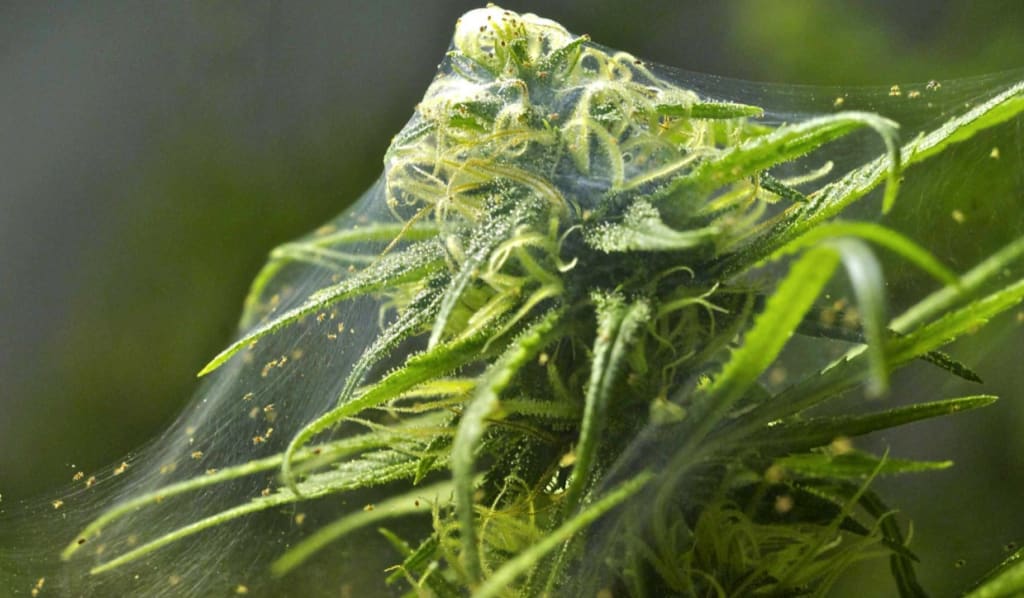Plant Pests - How to recognize them.
Spider Mites, aphids, whiteflies and others

Spider mites, thrips and others - how do I recognize and treat a pest infestation.
Like any other plant, cannabis is susceptible to animal pests and diseases that can weaken and destroy it. It is particularly important to check the plants regularly for signs of infestation, preferably with a magnifying glass. The following are the most common plant diseases caused by animal pests and their appearance.
Sciarid gnats
A sciarid gnat infestation can have serious consequences if prevention or action is not taken early on.
These tiny black insects are no longer than three to four millimetres and are mainly found indoors. They prefer a warm and humid environment where they feed on organic material (fungi) and soft parts of plants (roots). Adult animals prefer to lay their larvae in moist and rich soil, which provides the best conditions for their growth.
The plants suffer a loss of vitality - they grow worse, turn yellow and wither.
Sciarid fly, easy to recognize by its yellow belly
In order not to let it get that far, yellow glue traps and the surface of the earth help to dry out 2-3 cm before watering again. If there is a strong infestation with animal pests, benign nematodes should be used to kill the insects in the larval stage. The use of neem oil and the irrigation of the ground with diatomaceous earth have also proven themselves as natural and biological insect control agents.
Spider mites
This type of animal pest often occurs indoors when the humidity is too low. With their stinging and sucking mouthparts, they penetrate the plant tissue and damage it to such an extent that the areas turn yellow and die. The first signs are white spots on the leaves that can turn into black or yellow spots on the top and bottom. The spider mites are so tiny that with their brown to reddish-orange colour they could even be mistaken for spots. Another sign may be cobwebs that they spin in order to be able to move around and encircle the lower leaves and branches.
The web of spider mites, that's usually what you see first!
And those are the spider mites themselves, you can hardly see them without a magnifying glass
It is best to reduce the temperature, increase the humidity and ensure that there is sufficient air circulation.
If there is an infestation, all infested areas should be removed and the rest of the plant should be gently sprayed with a mixture of water and alcohol (90/10).
Fortunately, spider mites also have some natural enemies, such as ladybugs, netwings and special predatory mites that can be used in the weed garden.
Many essential oils such as neem, eucalyptus, cinnamon, lemon and rosemary oils can be mixed with water and applied to the plant and are used as mite control agents. But be careful: Avoid the flowers.
Thrips
Or also called bladder feet, suck the chlorophyll from the plant tissue and spread so quickly that countermeasures must be taken immediately. They are usually 1-1.5 mm in size and have a yellowish to white-yellowish body colour. In the adult stage, they can fly from plant to plant.
If you first notice a silvery sheen on the upper side of the leaves, which is occasionally accompanied by black traces of excrement on the underside, then you should immediately start with a treatment of potassium soap, neem oil or pyrethrum extracts, but natural predators such as ladybugs can also be used.
It is advisable to hang up blue adhesive strips as indicator traps, as the pests are attracted to the colour.
Aphids
They are about 1 to 3 mm in size and use their suction tubes to suck the juice out of the leaves. Aphids are found on the underside of the leaves and the stems. They can transmit viruses, bacteria and fungi, so you should examine your plants carefully several times a week in order to be able to act quickly and early in the event of an infestation. In the case of a severe infestation, growth is inhibited and the plant wilts, the leaves curl up (curl disease), develop yellow spots and dry up.
Since they hardly move, they can be removed by hand. There are also a number of beneficial insects, such as the lacewing larvae or parasitic wasps and ladybugs that feed on aphids. The use of pyrethrum every 5 to 10 days also helps in the fight against aphids. You should also make sure that the climate is not too dry.
Whiteflies
The whiteflies are related to aphids and scale insects. They too suck the sap from the plant on the underside of the leaves and, in the worst case, transmit viruses, which can lead to considerable damage and, as a result, to a loss of yield. The plant is so weakened that chlorosis occurs and the leaves wither. They also secrete a sticky sap, the so-called honeydew, which gives mould a breeding ground for the leaves and weakens the plant's ability to photosynthesize.
The fly is easy to spot, you only need to shake the plant and if it is infested you can briefly see the population swarming out. Here you can suck in flies from the air with a vacuum cleaner.
Again, spraying neem oil or potash soap every five days or using beneficial insects (lacewing larvae, predatory bugs) is very effective against the pests.
Since whiteflies spread faster at higher temperatures, you should always keep an eye on the climate and avoid temperatures above 27 ° C.
About the Creator
Dagga Seeds
Check Out Our Blog For Growing Tips, Cannabis Info And News
Enjoyed the story? Support the Creator.
Subscribe for free to receive all their stories in your feed. You could also pledge your support or give them a one-off tip, letting them know you appreciate their work.






Comments
There are no comments for this story
Be the first to respond and start the conversation.